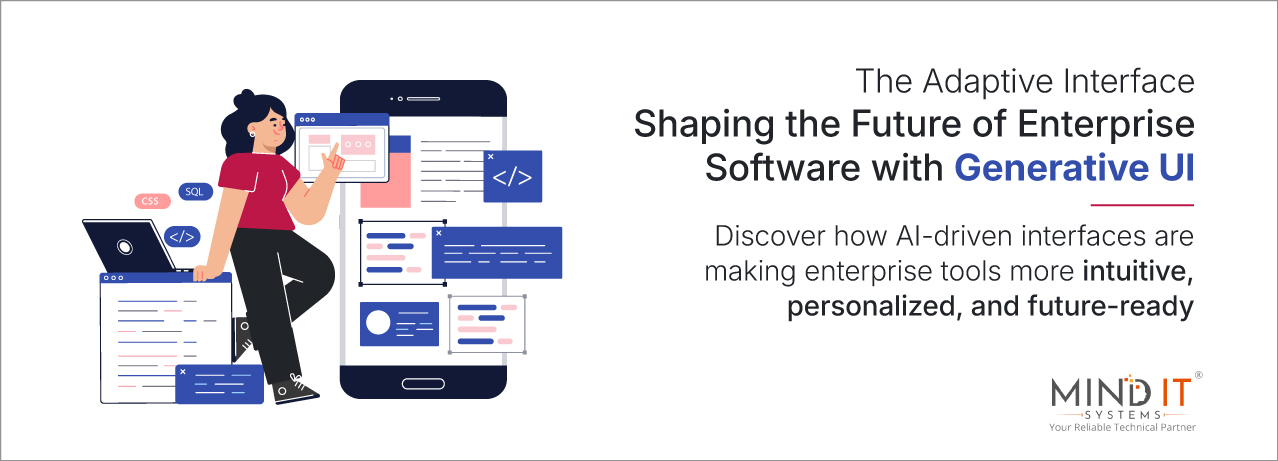
The Adaptive Interface: How Generative UI Is Shaping the Future of Enterprise Software
Imagine opening your enterprise app and seeing exactly what you need — no clutter, no wasted clicks.
That’s the promise of adaptive interface design, with Generative UI emerging as the next wave in enterprise UX. Unlike static interfaces that treat every user the same, Generative UI uses AI-driven personalization to adapt layouts, workflows, and navigation in real time.
It’s design that learns, evolves, and anticipates your needs — a huge leap for productivity, user satisfaction, and digital transformation.
In this article, let’s explore how adaptive interfaces are redefining enterprise software, why they matter now more than ever, and what lies ahead.
Why Static Interfaces No Longer Work for Enterprises
For years, enterprise software has been known for one thing — complexity. Fixed dashboards, rigid layouts, and workflows designed around systems rather than people.
That made sense once — stability and standardization were the priorities.
But today, business moves faster than ever. Teams are distributed, roles shift constantly, and users expect the same personalization they get from Netflix or Spotify.
A one-size-fits-all interface just can’t keep up anymore; the future belongs to software that adapts.
What Is Generative UI (and Why it’s Unique)
Think of Generative UI as a design that doesn’t stay still. Instead of a single static layout, AI helps generate and adjust the interface dynamically – based on who’s using it, what they’re doing, and what they might need next.
For example:
- A sales dashboard that automatically prioritizes active leads.
- A project management app that simplifies the view for new users and expands for experts.
- A customer support console that predicts and suggests next steps before an agent asks.
This is the power of AI in UX — design that’s not just intelligent, but empathetic.
From UI Design to Co-Creation: The Rise of Adaptive UX
Traditionally, designers defined every detail — grids, colors, interactions — down to the pixel. Generative UI shifts that approach from creation to co-creation.
Designers still set the intent, tone, and framework. But the system — powered by AI — learns from real-world use and adapts accordingly. It personalizes, reorganizes, and optimizes the experience for every user in real time.
This doesn’t replace designers; it empowers them. Instead of tweaking layouts endlessly, they can focus on higher-order questions: “How should the experience feel? What goals does it help users achieve?”
Top Benefits of Generative Interfaces in Enterprise Tools
Here’s why adaptive design is gaining traction in enterprise UX:
- Faster onboarding: Interfaces adapt to user roles and simplify learning.
- Higher productivity: Personalized layouts cut down navigation time.
- Scalable design systems: Maintain brand consistency while allowing flexibility.
- Reduced redesign cycles: The system evolves with feedback — not against it.
- Improved user satisfaction: When software fits naturally, adoption follows.
In essence, generative UX brings the human touch back to enterprise-scale systems.
Challenges and Ethical Considerations in Generative Design
With all its promise, Generative UI also brings a few challenges:
- Lack of human judgment: AI may recognize patterns, but it can’t empathize. It doesn’t reason about frustration or delight.
- Data privacy: Since the system learns from user behavior, responsible data management is essential
- Predictability: Over-adaptation can confuse users if the interface changes too often.
- Bias in AI models: Adaptive algorithms must be transparent, explainable, and fair.
The goal is to find the right balance between intelligence, control, and trust.
The Road Ahead: The Future of Adaptive Enterprise Software
The next generation of enterprise tools won’t just serve organizations — they’ll understand them. We’re heading toward software that continuously optimizes itself based on behavior, role, and intent.
At Mind IT Systems, we’re shaping that future — creating enterprise experiences that are intelligent, adaptive, and deeply human. Our purpose isn’t to chase trends or let AI take over design, but to make technology more responsive, contextual, and meaningful.
We use Generative UI where it helps — as a tool to accelerate, not define, our approach. Our focus is on truly adaptive systems: software that understands roles, learns from behavior, and evolves with intent. Because the future of enterprise UX isn’t about AI designing for people — it’s about AI helping software understand them.
Share this post
About the Author

Kanicka Gupta
“I’m a Tech founder with a strong belief: software should be easy, efficient, and feel good to use.
At Mind IT Systems, as Co-Founder and CExO, I work with enterprises to simplify complex workflows through custom technology—always keeping customer experience at the heart of the solution. If you believe technology should serve people—not the other way around—we’ll probably get along well.”

